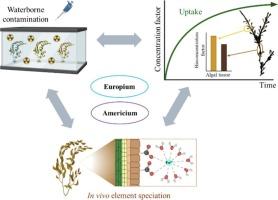Exploring Americium bioaccumulation in Ascophyllum nodosum seaweed through Europium as a surrogate: A kinetic and speciation study
IF 3.2
2区 化学
Q2 BIOCHEMISTRY & MOLECULAR BIOLOGY
引用次数: 0
Abstract
Studies of metallic radionuclides in oceans represent an important field of research. Because of their direct impact on marine ecosystems, they are especially important for assessing environmental health and safety. The high chemical – and radio – toxicity of heavy actinide elements makes them a particular threat to organisms, regardless of isotopy. Among these, americium is well known for its strong biosorption potential and combined chemo – radiotoxic effects. This study investigates the bioaccumulation of 241Am and of 153Eu (stable) and 152Eu as its chemical surrogate, in the brown macroalga Ascophyllum nodosum. Environmental analogies between 152Eu and 241Am are discussed, validating Europium as a reliable homolog in this system. Biokinetic accumulation models across trace and ultra-trace concentration levels are reported showing consistent behavior within the data, with a mono-exponential saturation pattern best fitting. Alginate was identified as a primary chelating agent, with speciation studies revealing potential alginate – Europium complexes in algal tissues. These findings highlight the essential role of algal polysaccharides in the uptake of metallic radionuclides and provide an entry into the ecological risk assessment associated with marine ecosystem contamination.

以铕为代用物探讨美洲元素在水藻中的生物积累:动力学和物种形成研究
海洋中金属放射性核素的研究是一个重要的研究领域。由于它们对海洋生态系统有直接影响,因此对评估环境健康和安全尤为重要。重锕系元素的高化学毒性和放射性毒性使它们对生物体构成特别的威胁,无论其同位素如何。其中,镅以其强大的生物吸附潜力和化学-放射性联合毒性作用而闻名。本研究研究了241Am和153Eu(稳定型)和152Eu(化学替代物)在褐藻紫穗藻(Ascophyllum nodosum)中的生物积累。讨论了152Eu和241Am之间的环境类比,验证了铕是该体系中可靠的同源物。据报道,痕量和超痕量浓度水平的生物动力学积累模型在数据中显示出一致的行为,单指数饱和模式最适合。藻酸盐被认为是一种主要的螯合剂,物种形成研究揭示了藻组织中潜在的藻酸盐-铕络合物。这些发现强调了藻多糖在金属放射性核素吸收中的重要作用,并为与海洋生态系统污染相关的生态风险评估提供了一个入口。
本文章由计算机程序翻译,如有差异,请以英文原文为准。
求助全文
约1分钟内获得全文
求助全文
来源期刊

Journal of Inorganic Biochemistry
生物-生化与分子生物学
CiteScore
7.00
自引率
10.30%
发文量
336
审稿时长
41 days
期刊介绍:
The Journal of Inorganic Biochemistry is an established international forum for research in all aspects of Biological Inorganic Chemistry. Original papers of a high scientific level are published in the form of Articles (full length papers), Short Communications, Focused Reviews and Bioinorganic Methods. Topics include: the chemistry, structure and function of metalloenzymes; the interaction of inorganic ions and molecules with proteins and nucleic acids; the synthesis and properties of coordination complexes of biological interest including both structural and functional model systems; the function of metal- containing systems in the regulation of gene expression; the role of metals in medicine; the application of spectroscopic methods to determine the structure of metallobiomolecules; the preparation and characterization of metal-based biomaterials; and related systems. The emphasis of the Journal is on the structure and mechanism of action of metallobiomolecules.
 求助内容:
求助内容: 应助结果提醒方式:
应助结果提醒方式:


